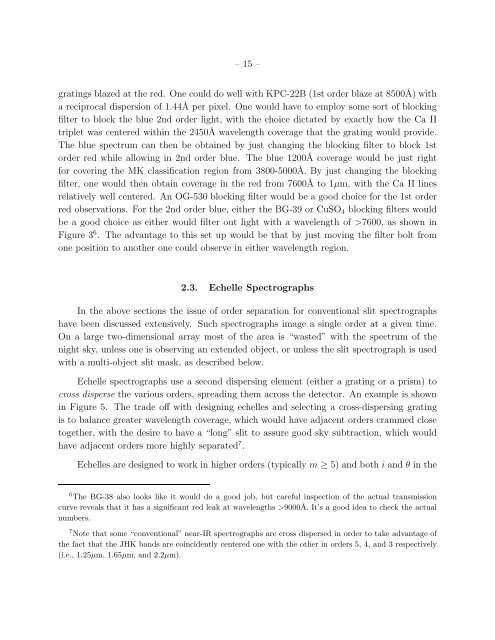Astronomical Spectroscopy - Physics - University of Cincinnati
Astronomical Spectroscopy - Physics - University of Cincinnati
Astronomical Spectroscopy - Physics - University of Cincinnati
Create successful ePaper yourself
Turn your PDF publications into a flip-book with our unique Google optimized e-Paper software.
– 15 –<br />
gratings blazed at the red. One could do well with KPC-22B (1st order blaze at 8500Å) with<br />
a reciprocal dispersion <strong>of</strong> 1.44Å per pixel. One would have to employ some sort <strong>of</strong> blocking<br />
filter to block the blue 2nd order light, with the choice dictated by exactly how the Ca II<br />
triplet was centered within the 2450Å wavelength coverage that the grating would provide.<br />
The blue spectrum can then be obtained by just changing the blocking filter to block 1st<br />
order red while allowing in 2nd order blue. The blue 1200Å coverage would be just right<br />
for covering the MK classification region from 3800-5000Å. By just changing the blocking<br />
filter, one would then obtain coverage in the red from 7600Å to 1µm, with the Ca II lines<br />
relatively well centered. An OG-530 blocking filter would be a good choice for the 1st order<br />
red observations. For the 2nd order blue, either the BG-39 or CuSO 4 blocking filters would<br />
be a good choice as either would filter out light with a wavelength <strong>of</strong> >7600, as shown in<br />
Figure 3 6 . The advantage to this set up would be that by just moving the filter bolt from<br />
one position to another one could observe in either wavelength region.<br />
2.3. Echelle Spectrographs<br />
In the above sections the issue <strong>of</strong> order separation for conventional slit spectrographs<br />
have been discussed extensively. Such spectrographs image a single order at a given time.<br />
On a large two-dimensional array most <strong>of</strong> the area is “wasted” with the spectrum <strong>of</strong> the<br />
night sky, unless one is observing an extended object, or unless the slit spectrograph is used<br />
with a multi-object slit mask, as described below.<br />
Echelle spectrographs use a second dispersing element (either a grating or a prism) to<br />
cross disperse the various orders, spreading them across the detector. An example is shown<br />
in Figure 5. The trade <strong>of</strong>f with designing echelles and selecting a cross-dispersing grating<br />
is to balance greater wavelength coverage, which would have adjacent orders crammed close<br />
together, with the desire to have a “long” slit to assure good sky subtraction, which would<br />
have adjacent orders more highly separated 7 .<br />
Echelles are designed to work in higher orders (typically m ≥ 5) and both i and θ in the<br />
6 The BG-38 also looks like it would do a good job, but careful inspection <strong>of</strong> the actual transmission<br />
curve reveals that it has a significant red leak at wavelengths >9000Å. It’s a good idea to check the actual<br />
numbers.<br />
7 Note that some “conventional” near-IR spectrographs are cross dispersed in order to take advantage <strong>of</strong><br />
the fact that the JHK bands are coincidently centered one with the other in orders 5, 4, and 3 respectively<br />
(i.e., 1.25µm, 1.65µm, and 2.2µm).

















